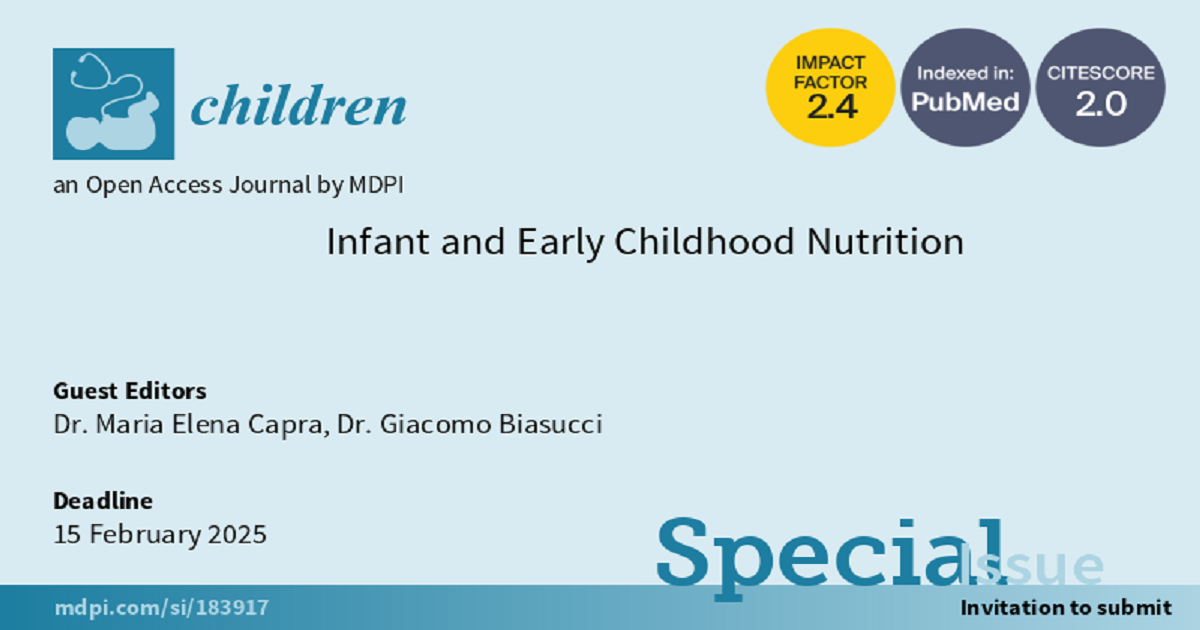Infant and Early Childhood Nutrition
A special issue of Children (ISSN 2227-9067). This special issue belongs to the section "Global Pediatric Health".
Deadline for manuscript submissions: closed (15 February 2025) | Viewed by 49534

Special Issue Editors
Interests: lipid metabolism; cardiovascular disease prevention; nutrition; childhood metabolic diseases; feeding disorders and nutrition in inborn errors of metabolism; nutrition in premature babies
Special Issues, Collections and Topics in MDPI journals
2. Department of Medicine and Surgery, University of Parma, 43126 Parma, Italy
Interests: infant and pediatric nutrition; inborn errors of metabolism; feeding and eating disorders of childhood; pediatric dyslipidemia; pediatric gut microbiota; pediatric food allergy
Special Issues, Collections and Topics in MDPI journals
Special Issue Information
Dear Colleagues,
We are pleased to announce a new Special Issue entitled “Infant and Early Childhood Nutrition” in Children, a peer-reviewed scientific journal indexed in the Science Citation Index Expanded (SCIE) and Social Sciences Citation Index (SSCI). The latest released impact factor for this journal is 2.4 (Journal Citation Report, 2022 Edition).
Nutrition is a milestone in the development of infants and children, especially in critical developmental stages such as breastfeeding and complementary feeding. Nutrition is an epigenetic factor that can modify the natural history of numerous non-communicable diseases. Moreover, nutrition in critical development stages can also facilitate taste development and food-related behavior.
This Special Issue welcomes original research articles presenting quantitative or qualitative data, as well as reviews addressing nutritional issues in infancy and early childhood.
Dr. Maria Elena Capra
Dr. Giacomo Biasucci
Guest Editors
Manuscript Submission Information
Manuscripts should be submitted online at www.mdpi.com by registering and logging in to this website. Once you are registered, click here to go to the submission form. Manuscripts can be submitted until the deadline. All submissions that pass pre-check are peer-reviewed. Accepted papers will be published continuously in the journal (as soon as accepted) and will be listed together on the special issue website. Research articles, review articles as well as short communications are invited. For planned papers, a title and short abstract (about 250 words) can be sent to the Editorial Office for assessment.
Submitted manuscripts should not have been published previously, nor be under consideration for publication elsewhere (except conference proceedings papers). All manuscripts are thoroughly refereed through a single-blind peer-review process. A guide for authors and other relevant information for submission of manuscripts is available on the Instructions for Authors page. Children is an international peer-reviewed open access monthly journal published by MDPI.
Please visit the Instructions for Authors page before submitting a manuscript. The Article Processing Charge (APC) for publication in this open access journal is 2400 CHF (Swiss Francs). Submitted papers should be well formatted and use good English. Authors may use MDPI's English editing service prior to publication or during author revisions.
Keywords
- nutrition
- infancy
- early childhood
- prevention
- breastfeeding
- complementary feeding
Benefits of Publishing in a Special Issue
- Ease of navigation: Grouping papers by topic helps scholars navigate broad scope journals more efficiently.
- Greater discoverability: Special Issues support the reach and impact of scientific research. Articles in Special Issues are more discoverable and cited more frequently.
- Expansion of research network: Special Issues facilitate connections among authors, fostering scientific collaborations.
- External promotion: Articles in Special Issues are often promoted through the journal's social media, increasing their visibility.
- Reprint: MDPI Books provides the opportunity to republish successful Special Issues in book format, both online and in print.
Further information on MDPI's Special Issue policies can be found here.
Related Special Issue
- Infant and Early Childhood Nutrition (2nd Edition) in Children (3 articles)







